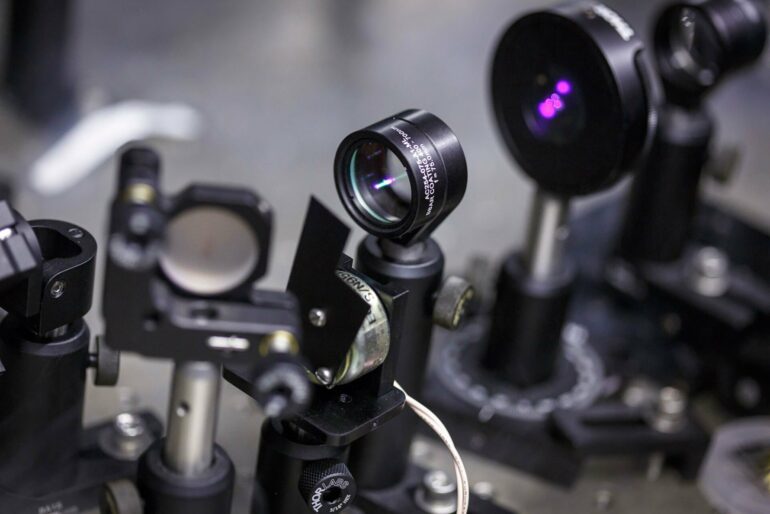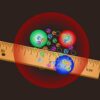Optics researchers at The University of Texas at Dallas have shown for the first time that a new method for manufacturing ultrathin semiconductors yields material in which excitons survive up to 100 times longer than in materials created with previous methods.
The findings show that excitons, quasiparticles that transport energy, last long enough for a broad range of potential applications, including as bits in quantum computing devices.
Dr. Anton Malko, professor of physics in the School of Natural Sciences and Mathematics, is corresponding author of a paper published online March 30 in Advanced Materials that describes tests on ultrathin semiconductors made with a recently developed method called laser-assisted synthesis technique (LAST). The findings show novel quantum physics at work.
Semiconductors are a class of crystalline solids whose electrical conductivity is between that of a conductor and an insulator. This conductivity can be externally controlled, either by doping or electrical gating, making them key elements for the diodes and transistors that underpin all modern electronic technology.
Two-dimensional transition metal dichalcogenides (TMDs) are a novel type of ultrathin semiconductor consisting of a transition metal and a chalcogen element arranged in one atomic layer. While TMDs have been explored for a decade or so, the 2D form that Malko examined has advantages in scalability and optoelectronic properties.
“LAST is a very pure method. You take pure molybdenum or tungsten, and pure selenium or sulfur, and evaporate them under intense laser light,” Malko said. “Those atoms are distributed onto a substrate and make the two-dimensional TMD layer less than 1 nanometer thick.”
A material’s optical properties are partially determined by the behavior of excitons, which are quasiparticles that can transport energy while remaining electrically neutral.
“When a semiconductor absorbs a photon, it creates in the semiconductor a negatively charged electron paired with a positive hole, to maintain neutral charge. This pair is the exciton. The two parts are not completely free from each other—they still have a Coulomb interaction between them,” Malko said.
Malko and his team were surprised to discover that excitons in LAST-produced TMDs lasted up to 100 times longer than those in other TMD materials.
“We quickly found that, optically speaking, these 2D samples behave totally differently from any we’ve seen in 10 years working with TMDs,” he said. “When we started to look deeper at it, we realized it’s not a fluke; it’s repeatable and dependent on growth conditions.”
These longer lifetimes, Malko believes, are caused by indirect excitons, which are optically inactive.
“These excitons are used as a kind of reservoir to slowly feed the optically active excitons,” he said.
Lead study author Dr. Navendu Mondal, a former UT Dallas postdoctoral researcher who is now a Marie Skłodowska-Curie Individual Fellow at Imperial College London, said he believes the indirect excitons exist due to the abnormal amount of strain between the monolayer TMD material and the substrate on which it grows.
“Strain-controlling in atomically thin monolayer of TMDs is an important tool to tailor their optoelectronic properties,” Mondal said. “Their electronic band-structure is highly sensitive to structural deformations. Under enough strain, band-gap modifications cause formation of various indirect ‘dark’ excitons that are optically inactive. Through this finding, we reveal how the presence of these hidden dark excitons influences those excitons created directly by photons.”
Malko said the built-in strain in 2D TMDs is comparable to what would be induced by pressing on the material with externally placed micro- or nanosize pillars, although it is not a viable technological option for such thin layers.
“That strain is crucial for creating these optically inactive, indirect excitons,” he said. “If you remove the substrate, the strain is released, and this wonderful optical response is gone.”
Malko said the indirect excitons can be both electronically controlled and converted into photons, opening a path to the development of new optoelectronic devices.
“This increased lifespan has very interesting potential applications,” he said. “When an exciton has a lifespan of only about 100 picoseconds or less, there is no time to use it. But in this material, we can create a reservoir of inactive excitons that live much longer—a few nanoseconds instead of hundreds of picoseconds. You can do a lot with this.”
Malko said the results of the research are an important proof-of-concept for future quantum-scale devices.
“It’s the first time we know of that anyone has made this fundamental observation of such long-living excitations in TMD materials—long enough to be usable as a quantum bit—just like an electron in a transistor or even just for light harvesting in a solar cell,” he said. “Nothing in the literature can explain these superlong exciton lifetimes, but we now understand why they have these characteristics.”
The researchers next will try to manipulate excitons with an electric field, which is a key step toward creating quantum-level logic elements.
“Classical semiconductors have already been miniaturized down to the doorstep before quantum effects change the game entirely,” Malko said. “If you can apply gate voltage and show that 2D TMD materials will work for future electronic devices, it’s a huge step. The atomic monolayer in 2D TMD material is 10 times smaller than the size limit with silicon. But can you create logic elements at that size? That’s what we need to find out.”
More information:
Navendu Mondal et al, Photoexcitation Dynamics and Long‐Lived Excitons in Strain‐Engineered Transition Metal Dichalcogenides, Advanced Materials (2022). DOI: 10.1002/adma.202110568
Provided by
University of Texas at Dallas
Citation:
Physicists shine light on solid way to extend excitons’ life (2022, June 20)



